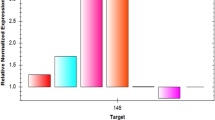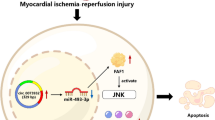Summary
Atorvastatin is proven to ameliorate cardiac hypertrophy induced by chronic intermittent hypoxia (CIH). However, little is known about the mechanism by which atorvastatin modulates CIH-induced cardiac hypertrophy, and whether specific hypertrophyrelated microRNAs are involved in the modulation. MiR-31 plays key roles in the development of cardiac hypertrophy induced by ischemia/hypoxia. This study examined whether miR-31 was involved in the protective role of atorvastatin against CIH-induced myocardial hypertrophy. H9c2 cells were subjected to 8-h intermittent hypoxia per day in the presence or absence of atorvastatin for 5 days. The size of cardiomyocytes, and the expression of caspase 3 and miR-31 were determined by Western blotting and RT-PCR, respectively. MiR-31 mimic or Ro 31-8220, a specific inhibitor of protein kinase C epsilon (PKCε), was used to determine the role of miR-31 in the anti-hypertrophic effect of atorvastatin on cardiomyocytes. PKCε in the cardiomyocytes with miR-31 upregulation or downregulation was detected using RT-PCR and Western blotting. The results showed that CIH induced obvious enlargement of cardiomyocytes, which was paralleled with increased atrial natriuretic peptide (ANP), brain natriuretic peptide (BNP), and slow/beta cardiac myosin heavy-chain (MYH7) mRNA levels. All these changes were reversed by the treatment with atorvastatin. Meanwhile, miR-31 was increased by CIH in vitro. Of note, the atorvastatin pretreatment significantly increased the mRNA and protein expression of PKCe and decreased that of miR-31. Moreover, overexpression of miR-31 abolished the anti-hypertrophic effect of atorvastatin on cardiomyocytes. Upregulation and downregulation of miR-31 respectively decreased and increased the mRNA and protein expression of PKCε. These results suggest that atorvastatin provides the cardioprotective effects against CIH probably via up-regulating PKCε and down-regulating miR-31.
Similar content being viewed by others
References
Peppard PE, Young T, Palta M, et al. Prospective study of the association between sleep-disordered breathing and hypertension. N Engl J Med, 2000,342(19):1378–1384
Gottlieb DJ, Yenokyan G, Newman AB, et al. Prospective study of obstructive sleep apnea and incident coronary heart disease and heart failure: the sleep heart health study. Circulation, 2010,122(4):352–360
Yaggi HK, Concato J, Kernan WN, et al. Obstructive sleep apnea as a risk factor for stroke and death. N Engl J Med, 2005,353(19):2034–2041
Minic M, Granton JT, Ryan CM. Sleep disordered breathing in group 1 pulmonary arterial hypertension. J Clin Sleep Med, 2014,10(3):277–283
Xie S, Deng Y, Pan YY, et al. Melatonin protects against chronic intermittent hypoxia-induced cardiac hypertrophy by modulating autophagy through the 5' adenosine monophosphate-activated protein kinase pathway. Biochem Biophs Res Commun, 2015,464(4):975–981
Maron DJ, Fazio S, Linton MF. Current perspectives on statins. Circulation, 2000,101(2):207–213
Dietrich A, Kalwa H, Gudermann T. TRPC channels in vascular cell function. Thromb Haemost, 2010,103(2):262–270
Totoson P, Fhayli W, Faury G. Atorvastatin protects against deleterious cardiovascular consequences induced by chronic intermittent hypoxia. Exp Biol Med, 2013,238(2):223–232
Chen Y, Yu S, Zhang N, et al. Atorvastatin prevents angiotensin II-induced myocardial hypertrophy in vitro via CCAAT/enhancer-binding protein p. Biochem Biophs Res Commun, 2017,486(2):423–430
Yuan X, Deng Y, Guo X, et al. Atorvastatin attenuates myocardial remodeling induced by chronic intermittent hypoxia in rats: Partly involvement of TLR-4/MYD88 pathway. Biochem Biophs Res Commun, 2014,446(1):292–297
Rybin VO, Steinberg SF. Protein kinase C isoform expression and regulation in the developing rat heart. Circ Res, 1994,74(2):299–309
Paul K, Ball NA, Dorn GW 2nd, et al. Left ventricular stretch stimulates angiotensin II-mediated phosphatidylinositol hydrolysis and protein kinase C epsilon isoform translocation in adult guinea pig hearts. Circ Res, 1997,81(5):643–650
Dekker LV, Parker P J. Protein kinase C~a question of specificity. Trends Biochem Sci, 1994,19(2):73–77
Disatnik MH, Buraggi G, Mochly-Rosen D. Localization of protein kinase C isozymes in cardiac myocytes. Exp Cell Res, 1994,210(2):287–297
McCarthy J, Lochner A, Opie LH, et al. PKCE promotes cardiac mitochondrial and metabolic adaptation to chronic hypobaric hypoxia by GSK3P inhibition. J Cell Physiol, 2011,226(9):2457–2468
Tao L, Bei Y, Zhou Y, et al. Non-coding RNAs in cardiac regeneration. Oncotarget, 2015,6(40):42613–42622
Greco CM, Condorelli G. Epigenetic modifications and noncoding RNAs in cardiac hypertrophy and failure. Nat Rev Cardiol, 2015,12(8):488–497
Silva AQ, Schreihofer AM. Altered sympathetic reflexes and vascular reactivity in rats after exposure to chronic intermittent hypoxia. J Physiol, 2011,589(6): 1463–1476
Joshi SR, Dhagia V, Gairhe S, et al. MicroRNA-140 is elevated and mitofusin-1 is downregulated in the right ventricle of the Sugen5416/hypoxia/normoxia model of pulmonary arterial hypertension. Am J Physiol Heart Circ Physiol, 2016,311(3):H689–H698
Ping P, Zhang J, Zheng YT, et al. Demonstration of selective protein kinase C-dependent activation of Src and Lck tyrosine kinases during ischemic preconditioning in conscious rabbits. Circ Res, 1999,85(6):542–550
Wang Y, Men M, Yang W, et al. MiR-31 downregulation protects against cardiac ischemia/ reperfusion injury by targeting protein kinase C epsilon (PKCe) directly. Cell Physiol Biochem, 2015,36(1): 179–90
Duan HY, Liu DM, Qian P, et al. Effect of atorvastatin on plasma NT-proBNP and inflammatory cytokine expression in patients with heart failure. Genet Mol Res, 2015,14(4): 15739–15748
Klusonova P, Rehakova L, Borchert G, et al. Chronic intermittent hypoxia induces llbeta-hydroxysteroid dehydrogenase in rat heart. Endocrinology, 2009,150(9):4270–4277
Scheubel RJ, Bartling B, Simm A, et al. Apoptotic pathway activation from mitochondria and death receptors without caspase-3 cleavage in failing human myocardium. JAm Coll Cardiol, 2002,39(3):481–488
An LP, An SK, Wei XH, et al. Atorvastatin improves cardiac function of rats with chronic cardiac failure via inhibiting Racl/P47phox/P67phox-mediated ROS release. Eur Rev Med Pharmacol Sci, 2015,19(20):3940–3946
Lu J, Liu F, Liu D, et al. Amlodipine and atorvastatin improved hypertensive cardiac hypertrophy through regulation of receptor activator of nuclear factor kappa B ligand/receptor activator of nuclear factor kappa B/ osteoprotegerin system in spontaneous hypertension rats. Exp Biol Med, 2016,241(11):1237–1249
Farh KK, Grimson A, Jan C, et al. The widespread impact of mammalian MicroRNAs on mRNA repression and evolution. Science, 2005,310(5755): 1817–1821
Brownlow N, Pike T, Crossland V, et al. Regulation of the cytokinesis cleavage furrow by PKCE. Biochem Soc Trans, 2014,6(42): 1534–1537
Jin ZQ, Karliner JS. Low dose N, N-dimethylsphingosine is cardioprotective and activates cytosolic sphingosine kinase by a PKCepsilon dependent mechanism. Cardiovasc Res, 2006,71(4):725–734
Author information
Authors and Affiliations
Corresponding authors
Additional information
This project was supported by the National Natural Science Foundation of China (No. 81370185 and No. 81570080).
Rights and permissions
About this article
Cite this article
Ren, J., Liu, W., Li, Gc. et al. Atorvastatin Attenuates Myocardial Hypertrophy Induced by Chronic Intermittent Hypoxia In Vitro Partly through miR-31/PKCε Pathway. CURR MED SCI 38, 405–412 (2018). https://doi.org/10.1007/s11596-018-1893-2
Received:
Revised:
Published:
Issue Date:
DOI: https://doi.org/10.1007/s11596-018-1893-2




